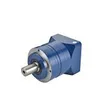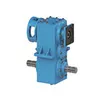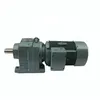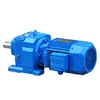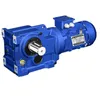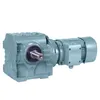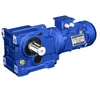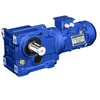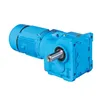A Helical Gearbox is a type of mechanical transmission system that utilizes helical gears to transfer motion and power between parallel or perpendicular shafts. Known for their efficiency, durability, and smooth operation, helical gearboxes are widely used in various industrial applications, including conveyors, mixers, elevators, and heavy machinery. The helical design of the gears allows for gradual engagement of teeth, reducing noise and vibration compared to spur gears, making them ideal for high-speed and high-torque environments.
Our helical gearboxes are engineered to meet rigorous industrial standards. Below is a detailed table of common specifications:
| Parameter | Range/Details |
|---|---|
| Gear Ratio | From 2:1 to 200:1, customizable based on application requirements. |
| Power Capacity | 0.12 kW to 200 kW, accommodating various motor sizes. |
| Input Speed | Up to 3000 RPM, suitable for high-speed operations. |
| Output Torque | Ranges from 10 Nm to 20,000 Nm, designed for high-load conditions. |
| Efficiency | 94% to 98%, depending on ratio and load conditions. |
| Mounting Options | Foot-mounted, flange-mounted, or shaft-mounted configurations available. |
| Material Construction | Gears: Hardened steel; Housing: Cast iron or aluminum alloy. |
| Lubrication | Oil bath lubrication; recommended oil types: ISO VG 68 to 220. |
| Protection Class | IP55, IP65, or higher for dust and water resistance. |
| Operating Temperature | -10°C to 90°C, with options for high-temperature adaptations. |
Helical gearboxes are utilized across multiple industries due to their reliability and performance. Common applications include:
Compared to spur or bevel gearboxes, helical gearboxes offer several benefits:
What is the main advantage of a helical gearbox?
The primary advantage is its ability to operate quietly and efficiently under high loads, thanks to the helical gear design that enables smooth and continuous tooth engagement.
How does a helical gearbox differ from a spur gearbox?
Unlike spur gears with straight teeth, helical gears have angled teeth that engage gradually, reducing noise and vibration, and allowing for higher speed and torque applications with better longevity.
What maintenance is required for a helical gearbox?
Regular maintenance includes checking oil levels every 500-1000 operating hours, replacing lubricant annually or as per manufacturer guidelines, and inspecting for wear or damage to gears and seals. Proper lubrication is crucial to prevent overheating and ensure optimal performance.
Can helical gearboxes be used in high-temperature environments?
Yes, with appropriate modifications such as high-temperature lubricants and materials, helical gearboxes can operate in temperatures up to 90°C or higher, depending on the specific design and insulation.
What factors should be considered when selecting a helical gearbox?
Key factors include required gear ratio, input/output speed, torque demands, power rating, mounting style, environmental conditions (e.g., temperature, dust, moisture), and compatibility with existing machinery. Consulting technical specifications and application needs is essential for optimal selection.
Are helical gearboxes customizable?
Absolutely. Manufacturers often offer customization options for ratios, sizes, materials, mounting configurations, and protection classes to meet specific industrial requirements and ensure seamless integration into various systems.
How long does a helical gearbox typically last?
With proper maintenance and under normal operating conditions, a helical gearbox can last 10-20 years or more. Lifespan depends on factors like load intensity, usage frequency, environmental conditions, and adherence to maintenance schedules.
What are common signs of helical gearbox failure?
Indicators include unusual noise (e.g., grinding or whining), overheating, oil leaks, vibration increases, and reduced efficiency or power transmission. Early detection and prompt repair can prevent major breakdowns.
Can helical gearboxes be repaired or must they be replaced?
Many components, such as gears, bearings, or seals, can be repaired or replaced individually if damage is localized. However, severe wear or catastrophic failure may necessitate full replacement to ensure reliability and safety.
Are helical gearboxes energy-efficient?
Yes, due to their high efficiency ratings (94-98%), helical gearboxes minimize energy loss during power transmission, contributing to lower operational costs and reduced environmental impact in industrial settings.
